«I’ve heard «You’re not going to make it and you’re never going to be that good» at college, at home, like… all the time, but I’m still here and I’ve held on to this because I like it and it makes me happy»
-Diana Zela
I met Diana Zela on a RTP[1]… well, I didn’t met her. There is where I first saw her. It was six o’ clock in the morning and it was one of those few times I didn’t have my headphones on, so I couldn’t isolate myself from the outside and when I realized I was looking at her.
I don’t remember how cold that day was, but I can remember that she was wearing a knitted hat, a jacket and a scarf. She was seating on one of those seats that are placed over the wheels, the kind that makes your legs stand a little higher and she make the use of it to leave her book on her lap while she was reading. After a minute or two of looking at her, I noticed how her reading had her inside of an invisible bubble. It was a bubble that only those who had the luck of stopping to look into the city’s chaotic and frenetic rhythm of life could see.
That day I realized we went to the same college, but we were never in the same class until two years later; and just by causality, we had to write a paper together. Diana has a very unique way of seeing things, and a sensibility, and often tenderness, that you can find on her works.
She was born in Mexico City, in ’91, being the youngest of four children and a resident of the Iztapalapa district, she talks about her family background with lots of love, admiration and respect. Her mother came to Mexico City in ’64, when Diana’s grandma decided to left her husband due to domestic violence. Pig breeding, selling stuff and lots of effort allowed her grandma to pay for her children’s education. Diana’s mother decided to study a technical career on Nursery and she worked seven days a week after her divorce, when Diana was a four year-old.
Diana coursed the Illustration speciality of the Design and Visual Communication B.A. at UNAM’s[2] former Escuela Nacional de Artes Plásticas[3], now FAD[4]. She also studied a diploma course on Scientific Illustration and developed a binding small business.
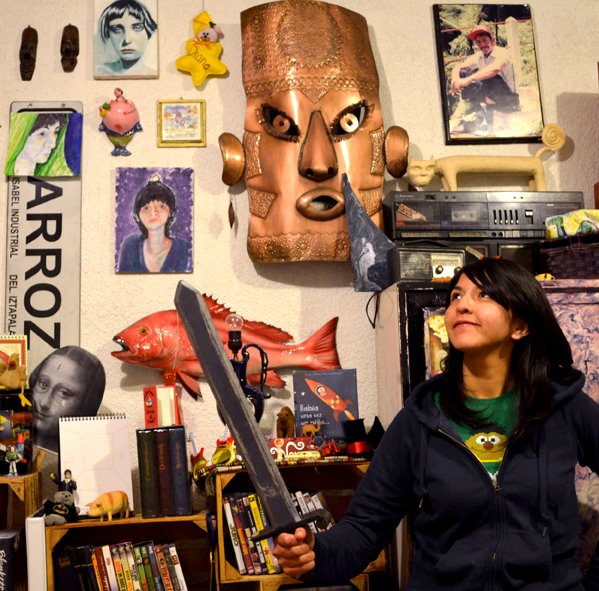
Diana Zela at her studio.
MAFA: Do you think there was something in your childhood that made you think «I want to devote myself to this?» Did something make you know from that moment that you wanted to become an illustrator?
D: I have an uncle who is like… he draws. He does screen printing and makes tee-shirts. He was the one who inspired my brother to draw. My brother is also an illustrator, but he is eight… nine years older than me. All the time I saw my brother drawing…. and painting… and doing stuff and well… I stole his comics and read them. Then I realized that it was cool to draw and to be able to tell stories through that, those comics really caught my attention. Before, I had the wish of studying filmmaking. Hence I took several courses: film workshops, storytelling classes, cinematographic stuff, affinity, special effects, make-up… then I realized that… working on film is doing teamwork and I [hahahaha] never found a team which I could work with, one I felt confortable with. By the way, I studied those things when I was 15, 16 years-old and all the people who attended the classes with me were 20, 30, even 35, 40 years-old, hahaha. Then… well, I was like the little child, like the «Yeah, let’s do this!» [in childlike voice] girl. Well, obviously, things not always ended well, so I discouraged myself of following that road and I realized that I can tell stories all by myself inside my cave: becoming an illustrator and that’s why I decided to follow this way.
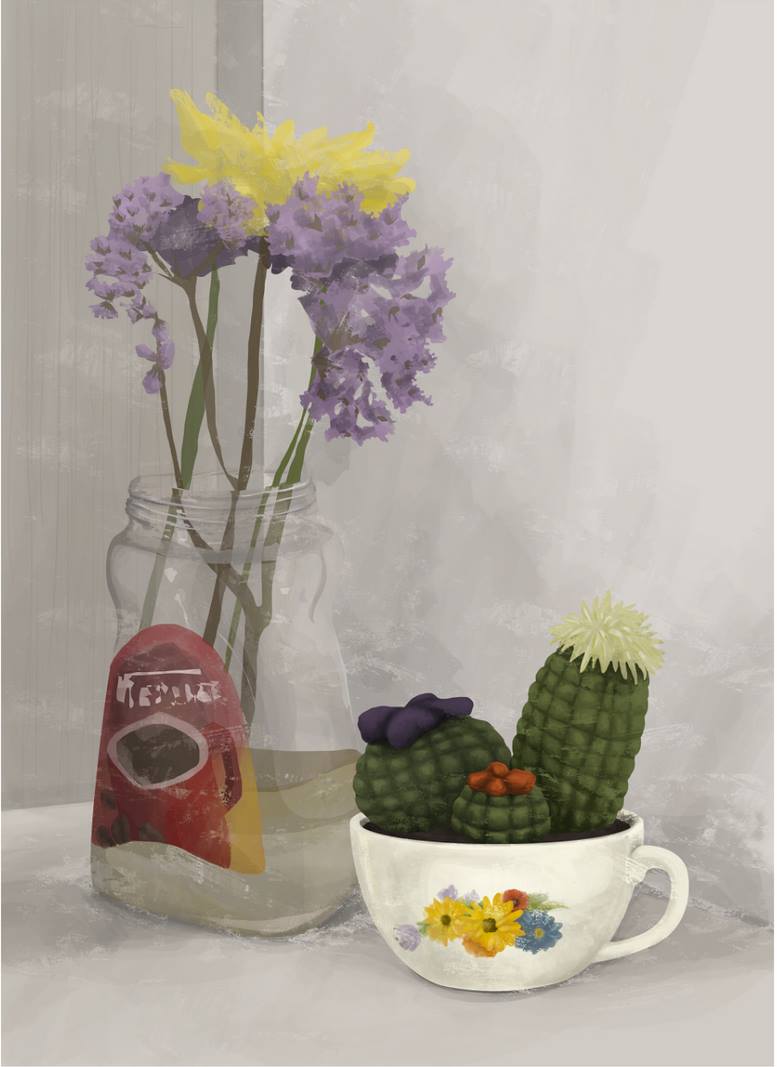
Untitled.
MAFA: There are lots of references to Literature in your illustrations and comics. How much your reader-self influences on your illustrator-self?
D: I think she influences a lot. Lately, just after I got my job, my brain couldn’t read more. I was so tired that … at the beginning, still when I just started my job, I take the subway and read, came back on the collective taxi and read. And before that, when I was at college, high school, middle school, reading was my life. I have a room full of books: children books, fiction, essays, scientific stuff, because I liked to read a lot. I love books too much and I like books like an object, but I stopped reading, I mean, like a formal reader since… two years ago, or three. but I still have in mind a lot of stuff from books, mostly from children’s books and sci-fi and bedtime stories that I like to revisit when I work. They’re still important for me.
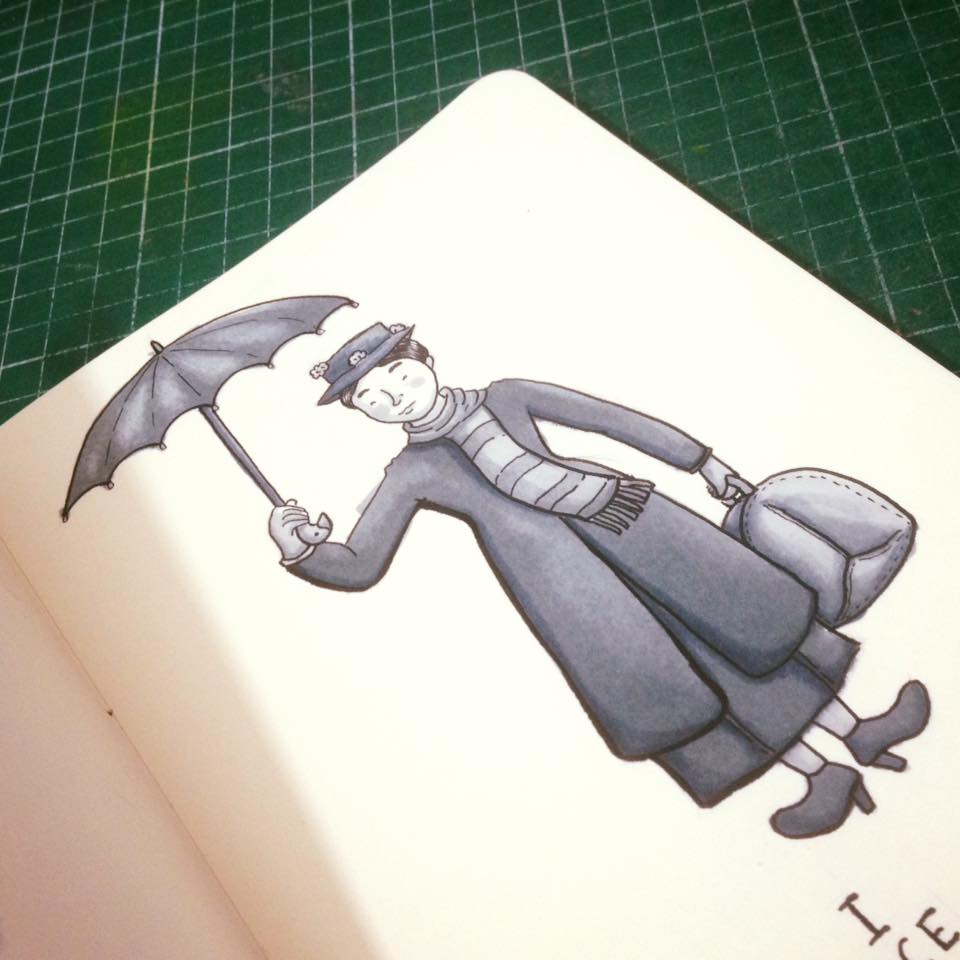
Illustration for «Inktober».
MAFA: Looks like you really love cartoons. I’m thinking of Adventure Time, hahaha. How this passion influences your work as an illustrator?
D: Like in animated shows? Well, I like them a lot, i think I always have liked to watch cartoons. I think I love them like many of us in the Art, Design and Illustration scene. We got over twelve and didn’t stop watching animation and kid’s shows. They entertain us. These days I’m such a big fan of a show named Bob’s Burgers.
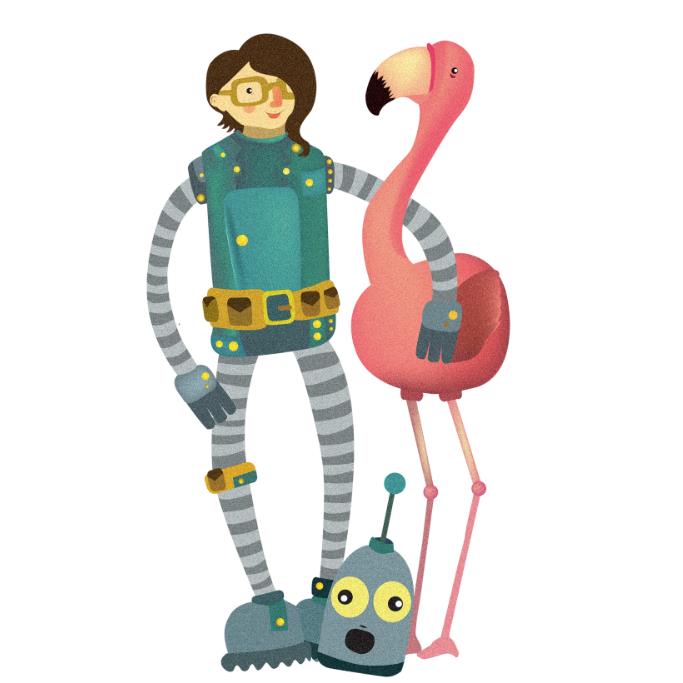
Untitled.
MAFA: Bo…? Bob’s…? Oh! Ok, Bob’s Burgers.
D: I love like… you know, the idea of a family sitcom with the opportunity to tell stories with animated cartoons directed to adults, and not necessarily to children. I like… cartoons. I think that, as well as every illustrator, it doesn’t matter how old we get, we’re always going to approach something to have fun while reinforcing ideas, to search for new ways of storytelling. Yeah, they’re very important in my life, like, for example, with this cartoon; what I like is that is an adult cartoon instead of a children’s one: a cartoon directed to adults. I’ve searched for fan’s forums and people share their experiences; «I saw this show with my children and I like that I can watch a show for me that my kids can also watch». It’s the idea of telling family stories through drawings and not necessarily on life action. I don’t know, I think it’s just cool.
MAFA: Then cartoons and Literature are what inspires you to create your characters, right?
D: Yes, they’re what I like the most.
MAFA: And what else? Is there something more? Like when you’re on the street and you say » the woman at the groceries…»
D: I used to do this weird thing: during my college years I didn’t have a car; I basically lived on the bus and the tram, and people approached me a lot and talked to me out of nothing. I was like [hahaha] with my book and headphones reading and middle-aged women and men came to me and talked with me about their days. Or I spent my trips to the campus watching the people on the bus, the things they did. Sometimes I came back from ENAP really late at night, I was coming to my house like at midnight, but I had to get off from the bus and walk up to the hill where I live. So, I was constantly… I don’t know if I was lucky or what [hahaha] but more that one time I sat with a homeless man outside the middle school I used to study at and he used to buy me a cup off coffee. «Yeah, I live in the streets because I got tired of living with my wife so I better left home». It was very weird, but homeless people talked with me pretty often [hahaha]. People on the streets talked with me very much, It was quite common that I met someone in the street, on my way back home, on public transportation. It was strange, because at school I turned away from everyone, but I was very interested on the stories around me, like the story of the «common man» who lives in the streets and nobody cares about him. I suppose I was very lucky and nobody ever killed or mugged me [hahaha] or anything else, I think I’m just lucky, I had this strong tendency to talk with strangers, I really liked to talk with them and sometimes when we ended talking I drew them. Technically speaking, my drawing is not that well, mmm, but I used to not care, you know? I was like «I’m gonna draw this nice fat woman who just gave me a torta[5] because…» I don’t know, I don’t know. I really had this approach to talking with people.

Untitled.
MAFA: You just said «I used to not care». Now do you?
D: Yes, I think that, for example, all this time I was working, my job was to draw, but to draw with vectors. I can tell you that for year and a half I didn’t take a pencil and I didn’t draw because I was too tired and overworked, and not… I haven’t drawn in a while, I returned to draw due to the textbook projects I got, and if it weren’t for that, I would probably delayed more my drawing and creative comeback. Because I did set it aside when I was working in an office. So, now I’m trying to return to draw, because I realized there are things I want to learn for myself, to improve my skills and to develop my technical abilities to tell something, because now I see my work back… I did a winter cleaning at home and moved my study room to my bedroom, so I found all my old sketchbooks and said: «Holy shit! They’re fucking hideous!». I have to sit down to draw, I have to improve this, It’s not possible that I still draw like I used to do so long ago. I did realize that I don’t draw like that anymore, bit I still don’t draw like I want to. Now I’m trying to reinforce that, to make use of my spare time to keep track of my exercises and improve my procedure.
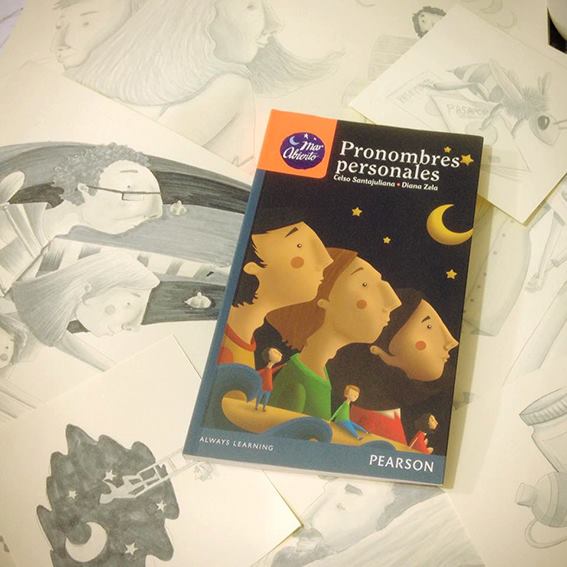
«Pronombres Personales /Personal Pronouns», illustration by Diana Zela.
MAFA: It caught my attention that you say «I still don’t draw like I want to» and I remember that you told me once in a class: «The hardest part it’s not to draw, but to tell a message or to let it reach your audience. To tell your story, to communicate something with drawings».
D: Yes, for example, it’s something… I used to worry pretty much about that, but, for example, all this time I was not drawing, I did write. For year and a half I was writing story-driven things, like short stories that I wanted to do and I started to read books about «How to Tell Stories», or «How to Create a Pitch» and I took a Diploma course on graphic narrative, I think my problem is no longer how to tell something, I feel that maybe I can now, I know how to express something through a drawing, but I feel something is missing. Right now I feel I lack something, that my weakness is that I can’t have the kind of drawing I need to tell the story how I want.
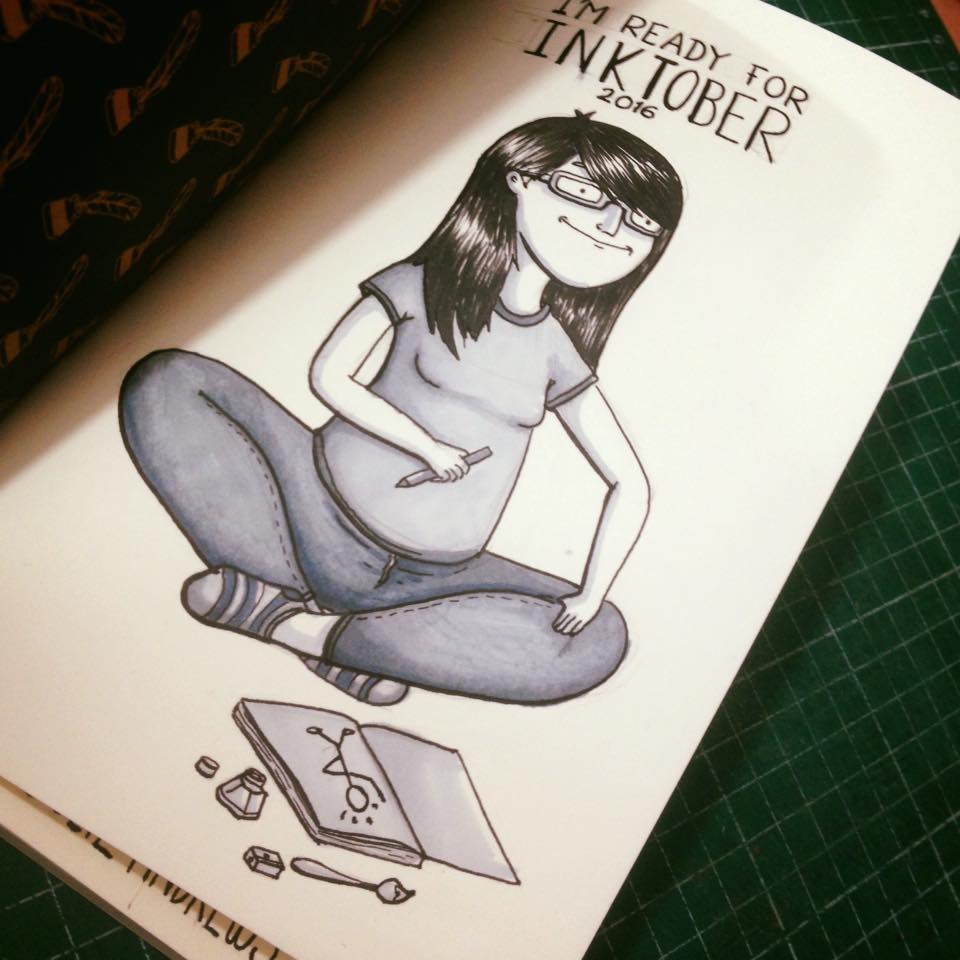
Illustration for «Inktober».
MAFA: Do you think there’s an influence from the Academy in your statement «I still don’t draw like I want to»? I mean. it is mostly an influence from the Arts College of «You must do it this way and this is how it must be, blah, blah, blah» or it is something that you built from your inner self in an autonomous way, or how it was?
D: I don’t think so, I was actually influenced by my B.A. formation. I have many acquaintances who hated to have to study at College and they think of it as the loss of four years of their lives, but I studied very hard at College. I attended classes with very good professors who taught me basic drawing canons, and, well, obviously you feel like they kill your creativity and you think «No, I want to draw like a great artist and express my feelings», but now I’m at a point that I realized that you can’t built everything without knowing the principles, right? Now I want to return to a more anatomical drawing, a bit more realistic, to later, when I’ll dominate it, direct myself where I want, but I do feel that my formation as an illustrator was made mostly by professors who gave me books like «Hey, look, check this paintings, go to the library, search for this artists and see how were their bodies, their lines, their ways of drawing». I feel that Art School taught me really well about that, but, there’s the issue that: I finished my B.A. like four years ago [hahaha], or three. I stopped drawing that way for almost four years and I feel it is something I need to retake to develop the line of work I’m interested in.
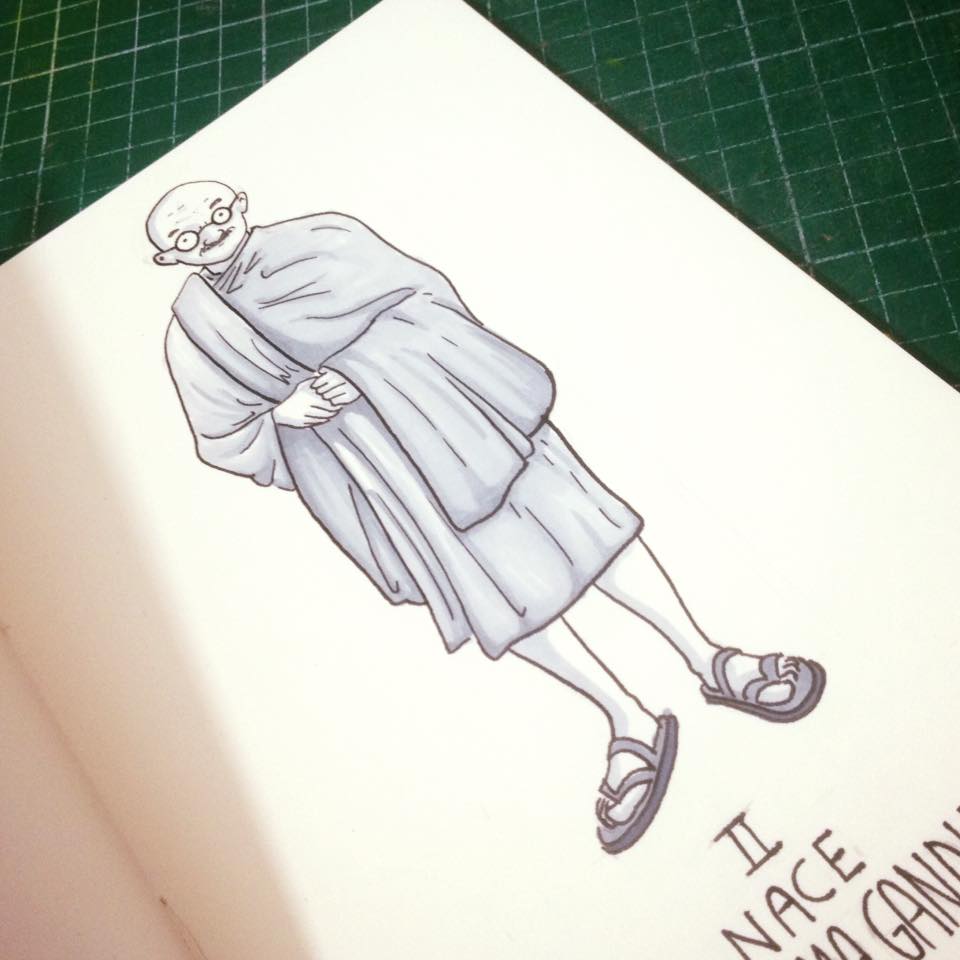
Illustration for «Inktober».
MAFA: I remember a professor who, overlooking some details, he basically said: «Not everyone can draw», this is not a profession for everyone, and, even if you like it and become passionate about it, if you’re not good at it, you’re not going to achieve it».
D: Yes, I think it says a lot about how… obviously, there’s people who were born with a gift, right?. My brother and my uncle, are the shit at drawing, they’re perfect, they can draw everything they fucking imagine and it comes out right, because, I mean, I feel there is something. Obviously if you were born «gifted» for drawing, things are gonna be easier for you, but just yesterday I was watching a video about a nice old lady, a Japanese who plays music and the lady was talking about how when you’re going to do something you wanna do, you must … there’s like three elements: one is obviously the gift and the facility to do something, but the other two elements are perseverance and that if you wish to master something and it is what you really want, you just need to practice to conquer it and obviously you’re going to have always against you that maybe you weren’t born as a person with developed gifts, but I, as an example, when they said at college «things that if you don’t know them yet you’re never going to learn» and «no matter how much you try you’re not going to be good at it». I think it’s something very stupid to say, right? I don’t know if it is absurd, but i do believe that «if you strive and the only thing you do all day is that, you’re going to achieve it». I think it’s more a thing of being able to know what you want and grasp to it. «And I’m going to grasp» and «I’m going to learn to draw no matter what and I’m going to devote it everyday». I don’t know, I feel is something more about commitment that being gifted, because I know people who are very good at drawing, but they’re not interested in it, so, they don’t do it. They can came in and say «Yeah, I can do a drawing of a female foreshortening and the proportion is perfect and my line…» But they don’t do it because they don’t want to do it.
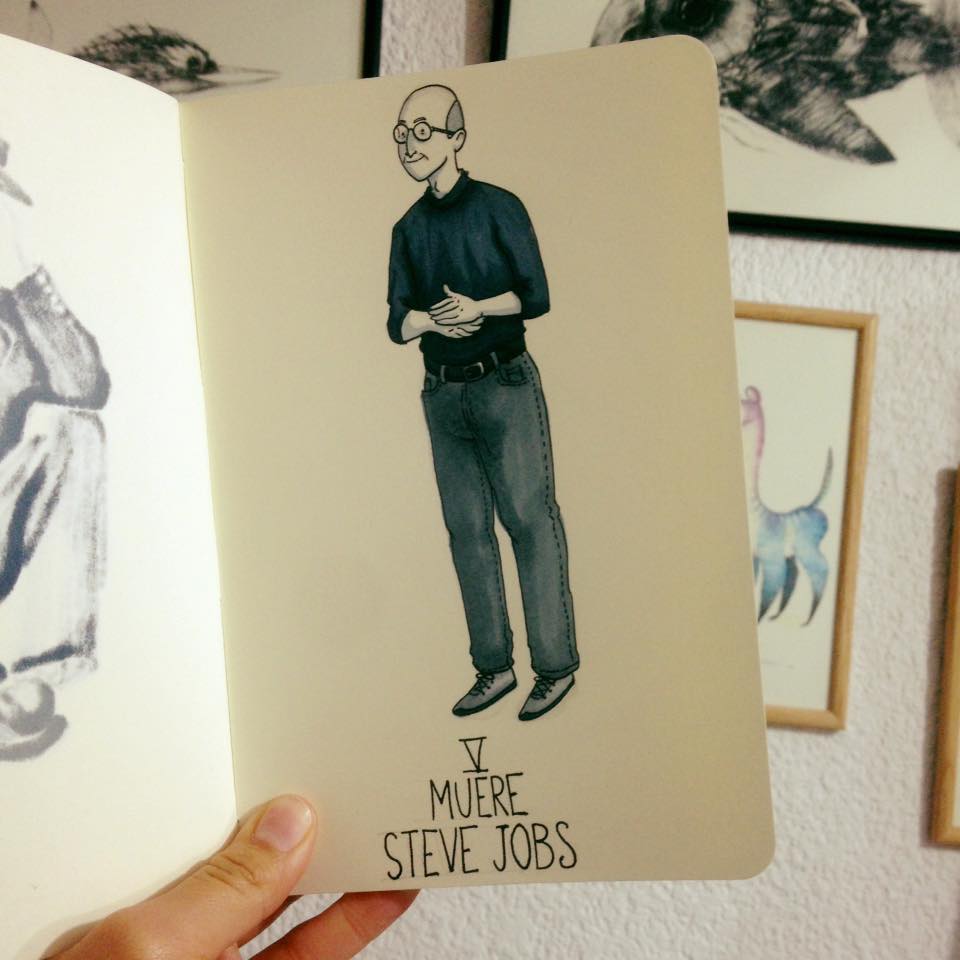
Illustration for «Inktober».
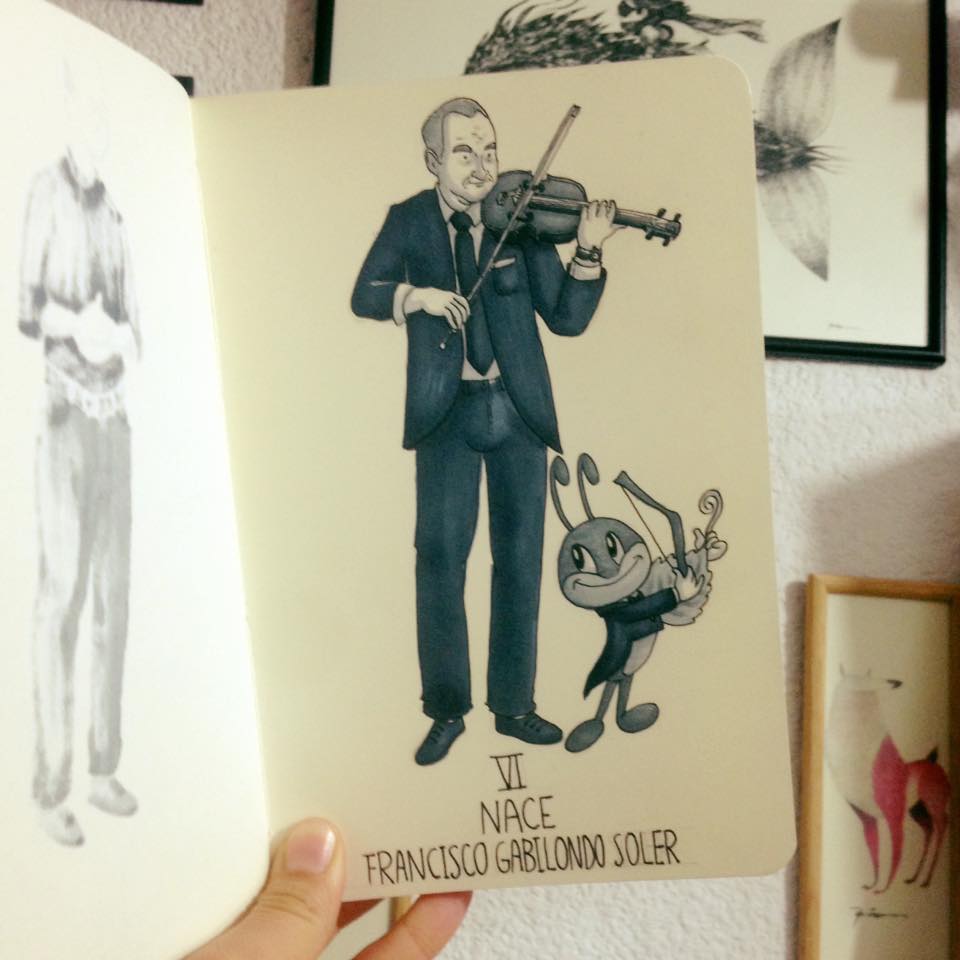
Illustration for «Inktober».
MAFA: Well, this is an observation of something I don’t only see in your work: I see self-portraits in your illustrations, you know? I see you in several of your characters, I actually think of them as self-portraits… and it’s very hard for me to stop thinking of it when I see them. But I realized this is something very common among women who illustrate. I mean, their characters are somehow based on themselves, but is something I’ve only seen in women. Why do you think this happens?
D: I ‘ve seen it also in men. My closest reference to someone who draws is my brother. I obviously know female illustrators. But with my brother I just remember how when I was a little kid I always said: «Richie is always drawing himself, right?» When I met my female friends who also illustrated I did realize that. I became aware that sometimes they didn’t want to do that. They just drew and it was like: «Damn, it’s me again!» But I think that… and somebody explained it to me once, it is a thing of: «You’re your greatest model». That’s something they said a lot to me in college and yo make them look like you. You see yourself a lot. You’re always looking at yourself in the mirror. You’re your better reference to create something, so, sometimes even when you don’t want to, when you draw, I feel there’s no way to avoid the «Oops! It’s me again». Because I’ve been living with myself for 27 years. Maybe it’s something we don’t know to exploit. I know of many female illustrators that do it on purpose, because it’s like: «Ah! I’m going to draw myself like doing this stuff». But I think that it happens to a lot of us in an incidental way. It’s like «Oh, no! It’s me again!» Because it’s me what I see everyday.
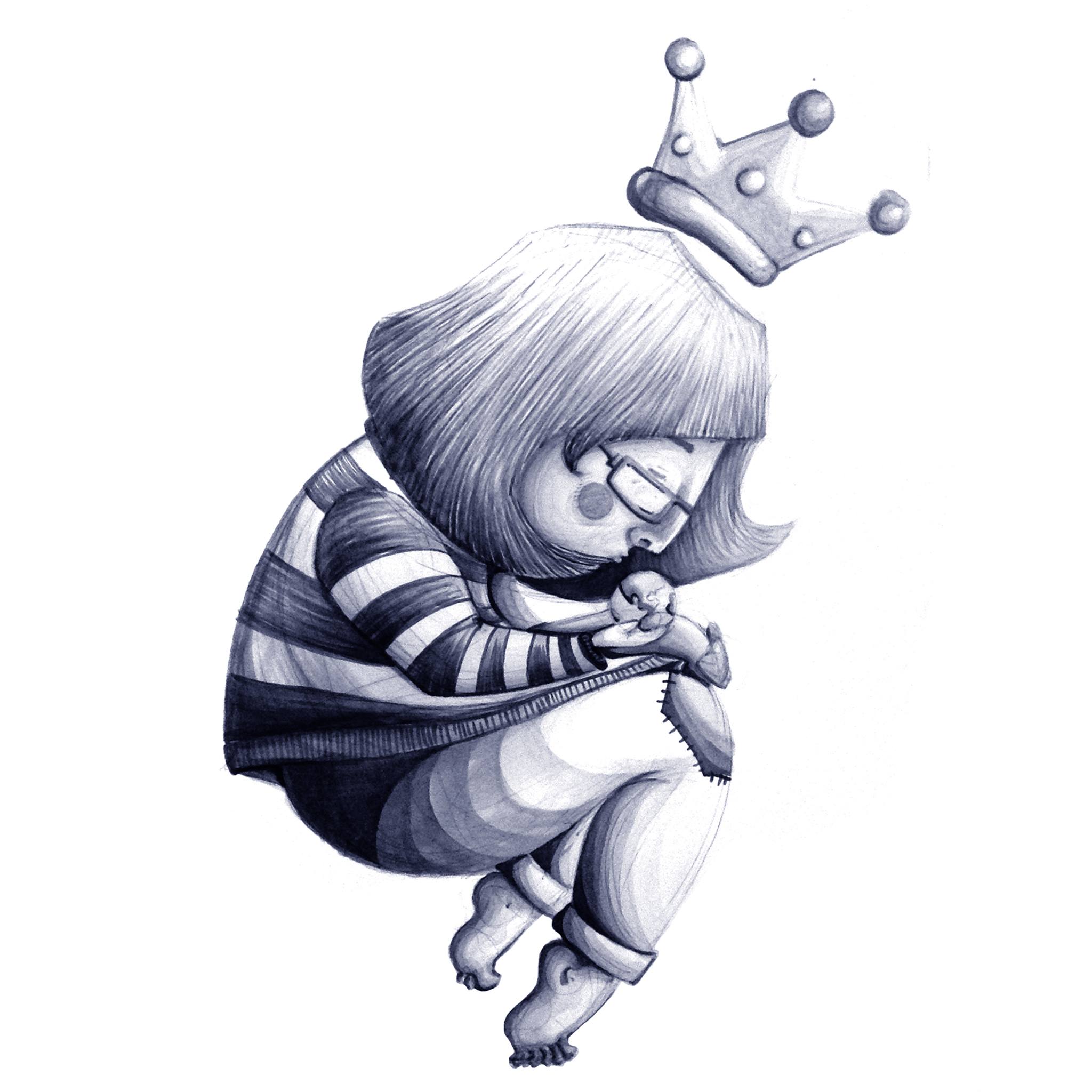
Untitled.
MAFA: It caught my attention that in a lot of your digital illustrations there’s a texture. There are textures or effects you use like grainy effects, like if you wanted to give it a non-digital touch.
D: Yes, I look at many text books for children and lately picture books are mostly digital illustrated and there’s people who.. I see it like «Ah! I make my drawings with vectors but I add to them textures so I feel that males them look less dead». It’s something I’m trying to retake. For example, I work on Illustrator. I’m very bad at Photoshop. Photoshop and I don’t get along [hahaha]. Obviously, for its characteristics, Illustrator tends to make flat results, then I do like: make my vectors and later import them to Photoshop and add them textures and stuff to make them look less flat, right? It’s my process. I don’t like a plain finish, volumeless.
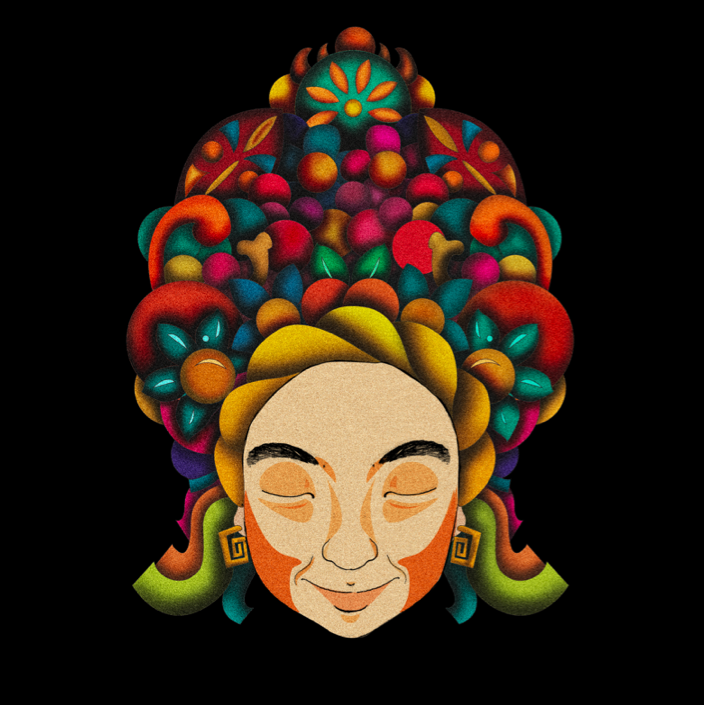
«Arte Popular/ Popular Art», Digital Illustration.
MAFA: How was your experience making an Art Toy? We saw your Piti Piti project, they were 3 or 4. Are you thinking of a similar project?
D: Yes, I have a series of characters like the ones in Piti Piti. I developed a character who was the main character of that course who was like some sort of monster who had some kind of tribal features, like face and skin paint and those were characters I had developed at some point and now that I have time, I want to finish the process of depict them in a threedimensional way. When I had the intention of doing a dissertation, hahaha, it was on toy-making. I always liked to model and sculpt, I attended workshops on that, and I found out the Plush Toy option, which is also like a kind of very- entertaining-to-craft sculpture. The possibility to take out your characters from the paper and make them a 3D work that someone can touch and interact with. I think is something that always got my attention and that was the first direction I wanted to head, sculpting and the making of threedimensional characters for toys, and for being contemplatives. it’s something I’m really interested in and something I want to follow up.

“Piti Piti”, Plush Toy.

“Piti Piti”, Plush Toy.
MAFA: Ok. We saw your «Tooth Fairy» sculpture, I think it has…
D: Yes, it has lots of…

«Tooth Fairy», sculpture.
MAFA: It caught my attention this uncommon way of portraying a fairy, and technically speaking it impressed me a lot.
D: It is… was… I made that sculpture like 6 or 7 years ago. I was in College and took a Saturday class with Francesca Dalla Benetta. She is an Italian sculptor who came to live in Mexico when they were filming Apocalipto. She goes and comes from Italy and has a very specific way of working. She works with epoxy clay, and mixes it with regular clay in a way that the material has a wide working time, and it doesn’t dry fast. The class project was like «Develop something, something for you», and I’ve always been interested on… I know everyone draws «cute, skinny girls», bur for me,… that idea… Mi mom is like thick, and with meat on her bones, and so do I, I have fat, a double chin, and well, that always caught my attention, so, when I decided to make the project for that workshop… I really wanted to develop a fairy, but I didn’t want a regular fairy, right? I thought of that tooth fairy who is always eating. I did want her to be very fat and that’s what I did. Actually, I still have her. It still needs to be painted, someday I’ll color her.
MAFA: Talk to us about the «Son las 2»[6] project. How it started? Why? What do you want to do with this project?
D: In college I took a couple of courses with MA Alicia Portillo. I really liked her way of teaching and later I realized how some classmates came with handcrafted notebooks. I’ve always liked books, so I’ve always liked the body of a notebook or a pad and I asked them: «Hey, where did you made that?» «-Oh! In Alicia Portillo’s workshop». Then I realized it was a class, an optional subject, and I enrolled in there. I pretty liked it. I didn’t know I liked to bind and I became passionate about the idea of a craftsman’s process of making something as simple as a notebook and that it could be learned in a B.A. I was in her workshop for a year and I started to have projects on binding. I actually only wanted to make my own sketchbooks, you know? With «my chosen paper and the size I want». That was my only intention, but people started to request some, then I published them in social media and it was like: «Hey, I want one too», and then offers started to pop-up and my boyfriend told me: «Well, if they ask you for these, why don’t you make another account for this?» Because I had my Facebook inbox filled up with messages like: «Hey, quote this for me, send pictures, and so on» and he add: «Maybe if you start a Facebook page for it you’ll have the chance to have more order in that», and I started it, it’s been 4 years and I’ve never stopped. We’ve never stopped to have projects. We’ve had very cool projects. I remember fondly how we went to work in a foster home for girls on Insurgentes avenue. A friend who is also an illustrator was doing her Master research with girls, she was teaching them to develop a comic, and she invited us to the foster home. She told us: «I use to go to the foster home and impart a drawing workshop, maybe you want to star a binding workshop». They were girls between seven and fourteen years. And well, my boyfriend and I arranged some basic binding kits and we went there to teach them a very basic binding technique and that was something we really loved. The idea of working with girls who aren’t used to the contact with other people felt very interesting. After that we started to have more offers… by acquaintances, like «that girl from Facebook who has a friend who has an agency that needs I don’t know what…» So we started to produce bigger and then was when I recruited my boyfriend and told him like: «Hey, you know what? [hahaha] You got me into this, so it’s your turn to help me». We have now three years in this. Sometimes we have a lot of work. We’ve worked for many agencies… we’ve also worked with Hula-Hula and have had projects on everything, things we’ve never expected. We made some Bibles for Google, leathered, we put our blood in them, we’ve done all, like, from the most commercial stuff to «artistic books» and obviously the most commercial things we do are sketchbooks for illustrators, but it’s a project that has never stopped, we actually haven’t grow, we haven’t pay for publicity to become known by people, it’s been mostly people who have come to us, like: «Oh! You do this». It’s been mostly word-of-mouth and that is how we keep the project alive.

«Son las 2» notebook.

«Inktober» notebook.

«El Túnel/ The Tunnel» book.

«El Túnel/ The Tunnel» book.

«El Túnel/ The Tunnel» book.
MAFA: There’s another project we saw named «La Patrulla Ñoña»[7]. What it is? Why it did start? Who are they?
D: It’s a fanzine project we have…. I have some friends from college, my three college friends from the illustration module. Arthur, Ray and Selma. Arthur has always pretty liked fanzines and one day, he told us: «Hey, I went to a fanzine gathering and look, they’re these». and then he showed them to us, and, well, they were very basic comic books. One day we were at his place eating pizzas and it was like: «Fuck! let’s make a fanzine right now» and then we grabbed some paper sheets. We were kinda drunk, kinda tired, we didn’t sleep well but we did a tiny little comic book, we xeroxed it and the next week we gave it away at a fanzine gathering and it seemed like it was quite a hit, kinda made them laugh and it succeeded. So we started and we said: «Hey! Ley’s keep ‘La Patrulla Ñoña’ alive.» And we worked very hard that year, we published an issue every two months. We achieved to publish six issues, as far as I remember, but later we all got jobs and we didn’t have time to continue it, but the idea was that everyone of us told a three-four pages story, to print it and hand it out at gatherings of people who do te same.

«Cuento de Una Tarde de Verano/ A Summer Afternoon’s Tale» comic strip for the «Patrulla Ñoña»
MAFA: Well, we know you do illustrations, animation (a little), comics, art toys… Which one is more important to you?
D: The most… right now I want to master illustration. But I think my goal has always been the concept of threedimensionalize my illustrations, so I think sculpting and modeling would be the right answer, and they may lead to stop-motion. I think right now, I want to master my drawing, but in the future I want to be able of translate those drawings into real life, to the third dimension, to later bring them to life, even if it’s in a very basic way. When I was in high-school I used to be like «Mmmm, I have this wire and some tape» and then I used to make some sort of dummies, with my Nokia I don’tknow I shot them and made some very quick stop-motion animations at my place in the afternoons. I really liked that and it was something I did all by myself, so it was like «Hey! I can animate this stuff by myself and I don’t have to argue with anyone else»… And just… I think my goal is something like that, to return to what I’ve always liked, which is film. My life was all about film before I entered college. So I think in some way I want to create things to return to that by myself. But yes, my idea is to learn about sculpting to later use in animation techniques I’m interested in.

«Piti Piti», Plush Toy.
MAFA: What would you say to these girls, women in general, who are thinking of starting a career in the Arts, or are already starting one, or to the ones who are hesitant because they’ve heard comments like the ones I told you: «No, you’re not good, you’re not gonna make it…».
D: Look, my brother is a very important part of my personal and artistic growth, etc. And I can tell you that he attended ENAP, and he was an outstanding student. The professors I had at the Illustration department had him as a student, so my last two years at my B.A. were a constant hearing of «Why don’t you make thing like your brother?», «Why you can’t do this?», «Why don’t you draw well?», «Why can’t you paint with acrylic paints?», «Why you don’t know how to paint with oils?», «Because your brother knows». It was like I was hearing that through my entire college, «Why if your brother is so good and such an outstanding illustrator… why you don’t?», «So… why don’t you pick another career», or «You’re good at this notepad stuff, right? Why don’t you live on that?». My first professor at college, it was a «Media exploring» class or something like that. He constantly told me… Actually, I started drawing just a few years before starting college, you know? I wasn’t like «I draw since I was a kid». Often since I started the B.A. they were like «Yikes! It’s not that perfect, you’re more artistic«. A lot of professors told me, they had this stupid idea: «God! If you’re not that good at drawing you must be a visual artist, you’re more expressive, you better change to the B.A. in Visual Arts [instead of Design]» or «It seems that your thing is Philosophy , you shouldn’t … don’t try it here, because, I think you’re not going to make it». I got those comments during my entire B.A. and I’m still here, you know? I’ve made a living on «doodling» since four years ago, hahaha. So, a lot of professors that have said those things, are professors who doesn’t practice, they only teach, they graduated and never found a job and they made a living of just teaching instead. So, one knows from who accept criticism and I didn’t take theirs, I know I’m not as technically good as most people tell me I should be because of the talent in my family, but, you know? I think it is something about making a stand of «Well, I don’t give a shit, I like to do this, and if I like it and it makes me happy and I’m not hurting someone else, then is no one’s business.». It was something I heard during my entire college experience and I saw my [female] classmates struggling with drawing, and other things and they heard like «Sigh! You should study something else». That kind of comments, a bit misogynous, like «Yikes! Maybe the Art life is not your thing». Like one has to get used…, I mean, sadly, you get used to listen to that kind of things and let them go, right? And you try to not care about them, and you keep going, but I think is something that happens. But if you like something, just do it. Mom always told me: «If you like something, just hold on to it and do it». When my brother said: «I’m going to be an illustrator», my father was like, obviously like all dads, «you’re going to die poor» [hahaha] «What are you going to live on?», and that sort of things, «You’re going to be a junkie», something like that. Buy they let my brother be, but when it was my time… Even after I graduated, my father still tells me: «Why don’t you better become an accountant?», «Would you like me to pay you a diploma course?», «I’ll pay you a B.A. in some thing [useful]», «Become an accountant», become anything [else]. «Become something you can deal with». Is a question of… in this case, not even my father has confidence in that I’m going to make it, you know? Mom says: «Don’t give a shit about that and do whatever you want, it doesn’t affects him.». So, I’ve heard: «You’re not going to make it, and you can’t do it, and you’re never going to be good at it» at school, at home, everytime, but I keep on going, and hold on to it, because I like it and it makes me happy, so, mom always tells me: «As long as it makes you happy, do it, and don’t care about anything else» and it’s what I’ve being doing and it has worked, I think, hahaha.

Untitled.
MAFA: Do you think in this case, that he told the same thing to your brother but let him go… and to you don’t , it was a gender thing?
D: I think it was, it was a thing of a lack… a lot of a lack of trust. My dad is a doctor, he is an anesthesiologist. He is a person who studied very hard. He is an immigrant. He is Peruvian. He came to Mexico when he was 16, he came with his cousins, and his backpack. My dad has a very interesting story. His entire family in Peru owns a bus line, and everyone works in it. My dad was sent to… and that was an argument my mom gave me to defend myself from him, you know? Dad came from Peru when he was 17, but his parents send him here to study aeronautics so his family’s business could grow as a transportation company and when Dad arrived he said: «No shit! I don’t want to study aeronautics!» He was studying at the Politécnico[8] like for a year and then dropped out and said: «I don’t like this, I’m going to be a doctor» and without telling anyone, he dropped out, entered to Med’ school and became a doctor and all the time he was here, his family thought he was studying another thing. My mom told me that and said: «So, when your dad comes and tells you why you’re not doing what he tells you to do, just remember him how he came to this country, because his family was also telling him to do something completely different and he decided to do what he liked». And I understand my father’s fear… He is an anesthesiologist, he doesn’t go through financial problems. He has four kids with my mom, and he has two other families. I have three half-siblings, that he can take care off because his job lets him sustain his families. I understand the logics behind our parent’s fear to not have economic stability, but my dad is also an odd case, because he wanted to study Medicine, but he wanted to be a cardiologist surgeon… or something like that. He wanted to study another specialty. But they didn’t have room for more students, so he had to become an anesthesiologist. He was in the field he wanted but not in the specialty he wanted to be, and he has this thing of «work has to feed you, but it’s not imperative that it makes you happy». So, he has a very well paid job. He has make a living of it for the last… I don’t know, 30 years of his life, but I’ve heard him saying thing like: «I work on this, maybe I don’t always enjoy it, but it is what I like to do.» My dad is going to retire from his first job and he’ll keep his other job and his jobs as a freelance worker, so, his now like: «Oh, I want to retake painting», so we talked on how my dad came to Mexico because he liked Green Lantern, and other superheroes comic books and he found how all superhero comic books came from Mexico[9]. So, he wrote to the publishing house in Mexico and told them: «Hey, I’m going to study in Mexico». And someone at the Publishing house took the time to wrote back to the Peruvian boy who wrote «Where can I study aeronautics?» or «Where can I study Medicine?» Someone gave him an address. Dad came to Mexico because someone at a comic book publishing house wrote him: «At Politécnico you can study what you want» And my mom says: «It’s ironic how your dad wants you guys to be outside the Art world when comic books were what brought him here in the first place». When my dad severely discouraged me about my future career, my mom told me: «Don’t listen to him». My mom kept stuff my dad gave her. She has one of his sketch albums. My dad used to draw a lot. He drew very well. He used to write poetry and had a very creative side that died when he started to work. My mom tells me: «Your dad was a lot like you guys when he was younger». Like in this way of: «I want to draw and create». That was something my dad used to do often, but because of family responsibilities he had to quit it and become dedicated to his job full-time. but now that he is going to retire he is like «I want to learn animation, I want to learn to paint», and hi buys his painting kits, but my dad thinks of this creative side of him as a hobby and entertainment that you can’t make a living of it. But he thinks even more like that when it’s about me. Because I’m the youngest of four siblings, at least… on my mom and dad’s side, and it’s like «Your brother already risked a lot, you better don’t, better search for something safer to make a living», and those are the kind of comments I hear constantly. Everytime I see him is: «She hasn’t even graduated», «She is not going to make it» or «Well, she has worked for publishing houses, and has illustrated freelance and has had a couple of exhibitions». «But I think it’s still a hobby». And it’s way a gender thing, because I’ve seen how it was with my brother. Yes, they argued and it was like: «No, Richie, study something else», «Be a lawyer», but that ended in his first year of college, when they saw how a great artist he was, and that he is the shit drawing. «He was published by someone». He had a short learning curve. He has won some contests and he has been successful. My dad always compared us: «Shit! When Richie was Diana’s age he was already published, he has had already won contests». And I’m a bit slower. Is like: «I’m going at my own pace, developing the things I want bit by bit», and I do understand our parent’s concern when we chose a career like this, but I fell that, as a woman, I’ve been more blamed than my brother, who is a man.

«Richard», Illustration.
MAFA: You say you sometimes write… Do you wish it to be published at some point?
D: Mmmm… I want to make some comic books. I normally, I don’t know if it’s something in my brain, but I have very vivid dreams, so I have this habit of having really weird dreams that have become the inspiration for the «Patrulla Ñoña» stories and things like that. They’re usually things I dream, since I was a child my mom… well, I always woke up and told her: Hey» I dreamt that I was with some unicorn-penguins in Antarctica and… I’ don’t know… silly, stupid stuff, and my mom was like: «C’mon, write it down», buy I’m not like a good writer. I’m not… well, I write like shit… if I write in Facebook… I’ve got lots of spelling mistakes and thing like that. I’m very bad at writing, I’m very bad at drafting, but I do like to tell stories, so, at some point I want to attend some classes for writing short stories… because just when I was studying film, there was this thing of… A screenwriter came and told us: «Well, among you guys: Who wants to be a director?» and we all raised our hands. «Well, we all want to be directors» and he told us: «And what are you going to direct?» «Which stories are you going to tell? The movie world can’t live just of adaptations, right?» Word. «Which new stories are you going to tell?» And I said: «Shit! That’s right!» Right? And then it was when I realized a bit, how we need people to write the stories. People who draw, who direct and who do all kind of things. They existed, but they always highlighted «We need people who tell stories». So, I want at some point to be able to develop my storytelling side, writing stories but reinforcing them as an illustrator, like in other things we like to do…

Diana Zela and her illustrations.
With churros, cinnamon and hot chocolate, the actual sweet note was added by Diana Zela.

«Orangutan» illustration.
After hearing and reading this interview, i’m sure lots of women will sympathize with Diana’s message. Hold on what you really want, look at where is criticism coming from and realize how actual creativity is only possible if it comes from your heart.

Rosaura Jiménez.
Designer with experience in Cultural Management and Logistics. Writes secretly some memories and dreams; she is an aesthetic sensations enthusiast.
The opinions expressed in the articles are those of the authors and do not necessarily reflect the views of Mujeres Artistas/ Female Artists.
[1] RTP stands for «Red de Transporte de Pasajeros» (Passenger Transportation Network). People from Mexico City calls the state-owned public transportation buses»RTP» to tell them apart from those of private companies.
[2] UNAM stands for «Universidad Nacional Autónoma de México» (National Autonomous University of Mexico). Is the most important public university in the country.
[3] National School of Visual Arts.
[4] FAD stands for «Facultad de Artes y Diseño» (Arts and Design Faculty).
[5] A kind of sandwich from Central Mexico.
[6] «They’re the 2»
[7] «The Sissy Squad»
[8] Instituto Politécnico Nacional (National Polytechnic Institute).
[9] At least in the 20th Century, Mexican translated editions of US comic books were published throughout Latin America.
